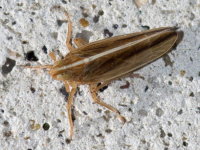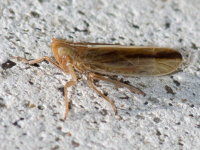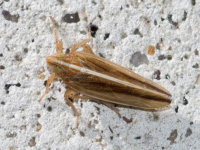Phylum Arthropoda (Arthropods) ➔ Subphylum Hexapoda (Hexapods) ➔ Class Insecta (Insects) ➔ Order Hemiptera (Hemipterans) ➔ Family Delphacidae (Planthoppers)
Stenocranus minutus (Fabricius, 1787)
Knaulgras-Spornzikade
Synonyms and other combinations:
Fulgora minutus Fabricius, 1787 | Fulgora minuta Fabricius, 1787 | Asiraca minuta (Fabricius, 1787) | Delphax lineola Germar, 1818 | Delphax longifrons Boheman, 1847 | Delphax longifronte Sahlberg, 1868 | Liburnia farinosa Buckton, 1890 | Stenocranus illabatus Rey, 1894 |
Classification:
Stenocranus minutus belongs to the subfamily Stenocraninae.Distribution:
Western Palearctic.Widespread in Europe.
Habitat:
Herbaceous layer of open moist to dry deciduous forests, bushes and hedges with adjacent meadows, riparian vegetation - in places where cock's-foot (Dactylis glomerata) occurs.Description:
Length ca. 4.5 - 6 mm; forewings light brown, often with a darker longitudinal stripe; head tapering upwards.Similar species:
Stenocranus minutus can easily be confused with other species of the genus Stenocranus.Biology:
Stenocranus minutus forms one generation per year outdoors.The adults leave their winter quarters during the first warmer days of early spring. About 4 weeks later, from the beginning of April, the females begin to lay eggs. The eggs are laid in clusters in the leaf sheaths of cock's-foot and covered with a wax powder coating. From the end of May onwards, the number of adults decreases and the first larvae hatch. These develop in summer. The adults of the new generation appear in the last days of August. They hibernate first and mate the following spring.
Natural enemies
An endoparasite of Stenocranus minutus is Cephalops pannonicus (synonym: Cephalops curtifrons) from the family of big-headed flies (Diptera: Pipunculidae). The females of Cephalops pannonicus lay their eggs into the 4th and 5th instar larvae of Stenocranus minutus. The Cephalops pannonicus larvae hatch and overwinter in their host. After the winter diapause they develop inside the host and leave it to pupate in the soil or leaf litter. The adult flies emerge when host larvae of Stenocranus minutus can be found for egg deposition.References, further reading, links:
- Bourgoin T. (2016). FLOW: Fulgoromorpha Lists On the WEB (version 8, Jan 2015). In: Species 2000 & ITIS Catalogue of Life, 2016 Annual Checklist (Roskov Y., Abucay L., Orrell T., Nicolson D., Flann C., Bailly N., Kirk P., Bourgoin T., DeWalt R.E., Decock W., De Wever A., eds). Digital resource at www.catalogueoflife.org/annual-checklist/2016. Species 2000: Naturalis, Leiden, the Netherlands. ISSN 2405-884X
- H. J. Müller: Über die Diapause von Stenocranus minutus Fabr. (Homoptera: Auchenorrhyncha), Beiträge zur Entomologie 7. Band, Nr.3/4, Berlin, August 1957.
- Yin Yin May: The biology of Cephalops curtifrons (Diptera: Pipunculidae), an endoparasite of Stenocranus minutus (Hemiptera: Delphacidae), Zoological Journal. Vol. 66, Part 1, 1979. 15-28 pp.


